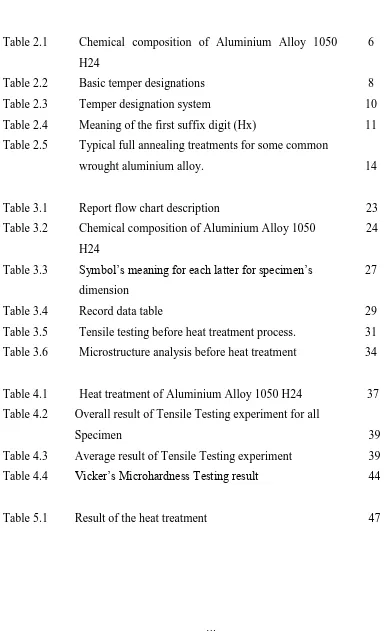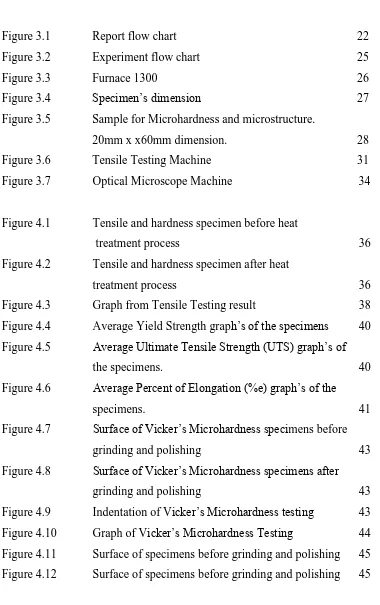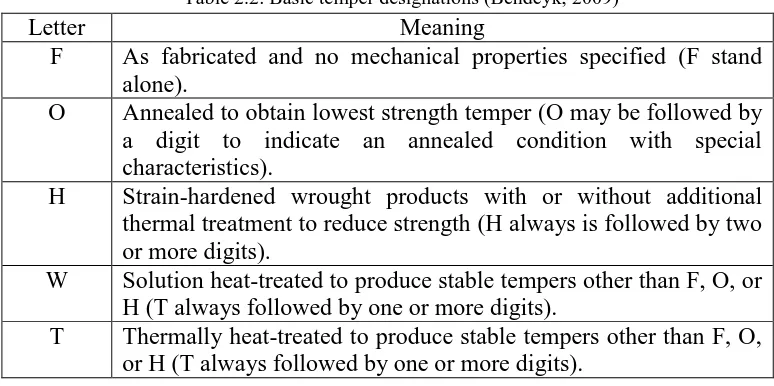UNIVERSITI TEKNIKAL MALAYSIA MELAKA
LARGE SCALE HEAT TREATMENT OF ALUMINIUM ALLOY
1050 H24 FOR FORMING PROCESS
This report submitted in accordance with requirement of the Universiti Teknikal Malaysia Melaka (UTeM) for the Bachelor Degree of Manufacturing Engineering
(Manufacturing Process)(Hons.)
by
NORAZLIN BINTI AJALI B050910188
900420015852
UNIVERSITI TEKNIKAL MALAYSIA MELAKA
BORANG PENGESAHAN STATUS LAPORAN PROJEK SARJANA MUDA
TAJUK: Large Scale Heat Treatment Of Aluminium Alloys 1050 H24 For Forming Process
SESI PENGAJIAN: 2012/13 Semester 2
Saya NORAZLIN BINTI AJALI
mengaku membenarkan Laporan PSM ini disimpan di Perpustakaan Universiti Teknikal Malaysia Melaka (UTeM) dengan syarat-syarat kegunaan seperti berikut:
1. Laporan PSM adalah hak milik Universiti Teknikal Malaysia Melaka dan penulis. 2. Perpustakaan Universiti Teknikal Malaysia Melaka dibenarkan membuat salinan
untuk tujuan pengajian sahaja dengan izin penulis.
3. Perpustakaan dibenarkan membuat salinan laporan PSM ini sebagai bahan pertukaran antara institusi pengajian tinggi.
4. **Sila tandakan (√)
SULIT
TERHAD
TIDAK TERHAD
(Mengandungi maklumat yang berdarjah keselamatan atau kepentingan Malaysiasebagaimana yang termaktub dalam AKTA RAHSIA RASMI 1972)
(Mengandungi maklumat TERHAD yang telah ditentukan oleh organisasi/badan di mana penyelidikan dijalankan)
Alamat Tetap:
NO. 8 Parit Asam Kumbang, 82200 Benut, Pontian, Johor Darul Ta’zim.
Tarikh: _________________________
Disahkan oleh:
Cop Rasmi:
Tarikh: _______________________
DECLARATION
I hereby, declared this report entitled “LARGE SCALE HEAT TREATMENT OF ALUMINIUM ALLOYS 1050 H24 FOR FORMING PROCESS” is the results of my own research except as cited in references.
Signature : ……….
Author’s Name : ………
APPROVAL
This report is submitted to the Faculty of Manufacturing Engineering of UTeM as a partial fulfillment of the requirements for the degree of Bachelor of Manufacturing Engineering (Process) (Hons.). The member of the supervisory is as follow:
………
i
ABSTRAK
Penggunaan Aluminium Aloi sangat meluas di bahagian industri disebabkan oleh kekuatan dan ketahanan bahan tersebut, tetapi satu ciri terbaik yang dimiliki oleh bahan ini adalah kekemasan permukaannya. Rawatan haba telah dilaksanakan dengan menggunakan Furnace 1300 ke atas bahan tersebut dengan suhu yang berbeza-beza, dalam lingkungan 350°C - 660°C. Setiap suhu mempunyai masa pemanasan yang berbeza, dalam lingkungan satu jam hingga dua jam, kemudian diikuti oleh proses pernormalan pada suhu 170°C selama 15 jam. Selepas itu, spesimen disejukkan di dalam suhu bilik. Semua spesimen diuji dengan ujian rengan menggunakan mesin ujian regangan. Specimen juga diuji dengan ujian mikro kekerasan menggunakan mesin uji Vickers. Berdasarkan eksperimen yang telah dijalankan, Aluminium Aloi H24 yang tidak melalui proses rawatan haba menghasilkan nilai yang lebih tinggi di dalam ujian regangan dan mikro kekerasan berbanding dengan Aluminium Aloi H24 yang telah melalui proses rawatan haba. “Optical Microscope” atau juga dikenali sebagai OM telah digunakan untuk
ii
ABSTRACT
Aluminium Alloy is widely used in industry because of high strength and hardness of the material, but one great characteristic is the surface finish. Heat treatment was performed using Furnace 1300 on the material with different temperature, ranging from 350°C - 660°C. Each temperature have different time of heating, ranging from one hour to two hour, and followed by normalizing process at 170°C for 15 hours duration. After that, specimens have been cooled at room temperature. All the specimens were test using tensile testing machine and microhardness testing using Vicker’s microhardness testing machine. From the conducted experiment, it shows
iii
DEDICATION
Ajali Bin Abd Rahim Noraini Binti Ahmed
Dr. Nur Izan Syahriah Binti Hussein Norazirah Binti Ajali
iv
ACKNOWLEDGEMENT
v
TABLE OF CONTENT
Abstrak i
Abstract ii
Dedication iii
Acknowledgement iv
Table of Content v
List of Tables viii
List of Figures ix
List of Abbreviations x
CHAPTER 1: INTRODUCTION 1
1.1 Background of Study 1
1.2 Problem Statement 2
1.3 Aim and Objective 2
1.4 Scope 3
1.5 Planning 3
1.6 Structure of report 4
CHAPTER 2: LITERATURE REVIEW 5
2.1 Aluminium Alloy 6
2.1.1 Properties of Aluminium Alloy 6
2.1.2 Aluminium Alloy 1050 6
2.1.3 Temper Designation Systems for Aluminium Alloys 7 2.1.3.1 Temper Designations System for Wrought Strain
Hardenable Aluminium Alloys 9 2.1.4 Aluminium Alloy in Industry Application 11
2.2 Heat Treatment of Aluminium Alloy 12
vi
2.2.2 Heating Equipment and Accessories 15
2.3 Grain Growth 17
2.4 Testing 18
2.4.1 Tensile Testing 18
2.4.2 Hardness Testing 20
CHAPTER 3: METHODOLOGY 21
3.1 Introduction 21
3.2 Report Flow Chart 22
3.3 Description for Report Flow Chart 23
3.4 Material 24
3.5 Experiment Flow Chart 25
3.6 Equipment 26
3.7 Specimen Preparation 27
3.8 Heat Treatment Process 29
3.9 Cooling Process 30
3.10 Testing and Microstructure 30
3.10.1 Tensile Testing 30
3.10.2 Microhardness Testing 32
3.10.3 Microstructure Analysis 32
3.11 Data Analysis 34
CHAPTER 4: RESULT 35
4.1 Introduction 35
4.2 Tensile Testing Result 37
4.3 Microhardness Testing Result 42
4.4 Grain Size Result 45
CHAPTER 5: DISCUSSION 47
5.1 Analysis of Tensile Testing Result 48
5.2 Analysis of Microhardness Testing Result 50
vii
5.4 Effect of Heat Treatment to Properties and Microstructure 52
CHAPTER 6: CONCLUSION AND RECOMMENDATION 54
6.1 Conclusion 54
6.2 Recommendations 55
REFERENCES 56
APPENDIX A 58
viii
LIST OF TABLES
Table 2.1 Chemical composition of Aluminium Alloy 1050 H24
6
Table 2.2 Basic temper designations 8
Table 2.3 Temper designation system 10
Table 2.4 Meaning of the first suffix digit (Hx) 11 Table 2.5 Typical full annealing treatments for some common
wrought aluminium alloy. 14
Table 3.1 Report flow chart description 23 Table 3.2 Chemical composition of Aluminium Alloy 1050
H24
24
Table 3.3 Symbol’s meaning for each latter for specimen’s dimension
27
Table 3.4 Record data table 29
Table 3.5 Table 3.6
Tensile testing before heat treatment process. Microstructure analysis before heat treatment
31 34
Table 4.1 Heat treatment of Aluminium Alloy 1050 H24 37 Table 4.2 Overall result of Tensile Testing experiment for all
Specimen 39
[image:12.595.111.495.121.752.2]Table 4.3 Average result of Tensile Testing experiment 39 Table 4.4 Vicker’s Microhardness Testing result 44
ix
[image:13.595.112.492.106.711.2]LIST OF FIGURES
Figure 3.1 Report flow chart 22
Figure 3.2 Experiment flow chart 25
Figure 3.3 Furnace 1300 26
Figure 3.4 Specimen’s dimension 27
Figure 3.5 Sample for Microhardness and microstructure.
20mm x x60mm dimension. 28
Figure 3.6 Tensile Testing Machine 31
Figure 3.7 Optical Microscope Machine 34
Figure 4.1 Tensile and hardness specimen before heat
treatment process 36
Figure 4.2 Tensile and hardness specimen after heat
treatment process 36
Figure 4.3 Graph from Tensile Testing result 38 Figure 4.4 Average Yield Strength graph’s of the specimens 40 Figure 4.5 Average Ultimate Tensile Strength (UTS) graph’s of
the specimens. 40
Figure 4.6 Average Percent of Elongation (%e) graph’s of the
specimens. 41
Figure 4.7 Surface of Vicker’s Microhardness specimens before
grinding and polishing 43
Figure 4.8 Surface of Vicker’s Microhardness specimens after
grinding and polishing 43
x
Figure 4.13 Microstructure of Specimen 1, which is raw material, Aluminium Alloy 1050 H24 from optical Microscope
with magnification of 100X. 46
Figure 4.14 Microstructure of Specimen 13 from Optical
Microscope with magnification of 50X. 46
Figure 5.1 Tensile stress-strain behaviors for both ductile and
brittle metals 50
Figure 5.2 Graph of Ultimate Tensile Strength (UTS) with Average Vicker’s Microhardness (HV) for the
x
LIST OF ABBREVIATIONS, SYMBOLS AND
NOMENCLATURE
Al - Aluminium
x
LIST OF ABBREVIATIONS, SYMBOLS AND
NOMENCLATURE
Al - Aluminium
1
This chapter presents the background of study, problem statement, aim and objective, scope, planning, and the structure of the whole report. Background of study describes generally about Aluminium Alloy 1050 H24. Problem statement describes the problem heading. Aim and objective states the main point of this study and scope describe the topic cover for this study.
1.1 Background of Study
Aluminium Alloy 1050 H24 is mostly pure aluminium that has a high strength and hardness. That is one of the reasons why Aluminium Alloy 1050 H24 is rarely being used. But, the surface finish of this material is great, and makes the industry attract to use them. Actually, a camera company has faced a problem in forming the material due to the high strength and hardness. Aluminium Alloy 1050 H24 will be form as housing of camera after undergoes stamping process. This study wants to observe if the high strength and hardness can be reducing using heat treatment process to make the forming process flow smoothly.
2
1.2 Problem Statement
Murakami et al. (2006) states that the aluminium alloys are increasingly utilized recently. It is to improve fuel consumption of vehicles by reducing their weight, and their excellent workability, corrosion resistance, and recyclability. Lim et al. (2012)
it can be easily fabricated. Compared to stainless steel, Al 1050 Al 1050 has better
electrical resistance than stainless steel, and the thermal conductivity of Al 1050 is
8.5 times greater than that of stainless steel. Due to Jimenez et al. (2009) the ultimate
tensile strength is 105 MPa, the yield strength is 75 MPa, and the Vickers hadrness is 44. While undergo stamping process, it is a little bit difficult due to the high strength and hardness. It will make many step of stamping process needed and also lead to defects. Heat treatment process is used to reduce the high strength and hardness of Aluminium Alloy 1050 H24.
1.3 Aim and Objective
The aim of this study is to reduce the strength and hardness of aluminium alloy 1050 H24. This reducing of strength and harness will make the step of forming process being reduced. The objectives of this study are:
(i) To characterize the microstructure and properties of Aluminium Alloy 1050 H24 before heat treatment.
(ii) To observe the effect of heat treatment parameters to microhardness of Aluminium Alloy 1050 H24.
3
1.4 Scope
The scope of this study is to investigate the effect of microstructure of Aluminium Alloy 1050 H24 before and after heat treatment and microhardness processing. Heat treatment that will be used is heating in the furnace. Parameters of heat treatment process also important to achieve the objective. The parameters that will be included are temperature for heat treatment, time of heating and cold process.
1.5 Planning
Planning make our work systematic and arranged. Here, Gantt Chart have been build for my progress of my report. There are only 12 weeks to complete this first report. The presentation of the report will occur at the weeks of 13. As i get my title in week one, then, the discussion about the title was held in week two. Then, a little bit of time is needed to search as much information to make more understanding in this topic.
At week three and four, this is the time to refer to the journal, articles, standards and brainstorming for what to do in this report. Find the other research to study and investigate how they conduct the experiment. The journal and articles will be as references to do this report.
At week five, discuss how to make the actual report, such as format, standard, planning, and so on. After the discussion, at the week six and seven, start to do the chapter 1 of the report. Following week eight, nine and ten, planning to do the chapter 2, and week ten, eleven, and twelve do the chapter 3. The actual presentation will be held on the week of thirteen. The Gantt chart can be seen at Appendix A.
4
experiment until week 11. After that, week 12 until week 15 to do analysis and report writing. Lastly, checking for the entire report.
1.6 Structure of report
The summary of each chapter is described in the structure of report. The structure of the report includes Chapter 1 until Chapter 5 of the report.
Chapter 1: Introduction
Include the background of the study, problem statement, experimental design, objectives, scope and study management of the whole report.
Chapter2: Literature Review
Literature review on composition, properties, application, heat treatment, and testing of Aluminium Alloy.
Chapter 3: Methodology
The methodology of the study contains a brief explanation about the preparation of the experiments including the equipment used measurement on specimen preparation, heat treatment process, testing, and microstructure analysis.
Chapter 4: Result The result presented.
Chapter 5: Discussion
Discussion for the result. The data will be analyzed.
Chapter 6:Conclusion and Recommandations
5
This chapter presents the literature review on material, which is Aluminium Alloy 1050, properties of Aluminium Alloy, temper designations, heat treatment process and other related subjects. This chapter describe the properties of material, application, heat treatment process, tensile testing and microhardness test.
2.1 Aluminium Alloy
Ambroziak and Korzeniowski (2010) stated that aluminium as a pure metal is known since the beginning of the 18th century. It was extracted and isolated by Oersted (1825). Although the massive production method of extraction aluminium from its ore bauxite was discovered in the second half of 18th the century, the process in its basis is has been using until today. The mechanical strength of pure aluminium is relatively weak; this is the reason that for constructional purposes is used rarely. To increase the mechanical strength of pure aluminium some alloy elements are added, mainly silicon, magnesium, copper and zinc. Currently, aluminium alloys are common used in aircraft, military industry and automotive industry.
6 2.1.1 Properties of Aluminium Alloy
Ambroziak and Korzeniowski (2010) also said that aluminium and its alloy are a silvery white which have density from 2.6g/cm3 up to 3.0g/cm3. Although pure aluminium is light metal, the mechanical strength of some its alloys exceeds the strength of mild steel. It has high thermal and electrical conductivity, high reflectivity to both heat radiation and the light. It is non-magnetic material. The characteristic feature of aluminium is that there is no color change during heating. The melting temperature of pure aluminium is 660 ºC (1220 ºF). Aluminium alloys have approximately melting range from 480 ºC (900 ºF) up to 660 ºC (1200 ºF), it depends of the composition of alloying components.
It was mentioned the pure aluminium is not used as a material for mechanical constructions. To make it stronger alloying ingredients as copper, zinc, manganese, magnesium, silicon are applied. The designation of aluminium alloys indicates directly the form and composition of alloys and main alloying elements. The first digit identify the main alloying elements, the last three the composition of alloy. There are two forms of aluminium alloys which are:
(a) wrought alloys (b) casting alloys.
2.1.2 Aluminium Alloy 1050
[image:22.595.129.512.677.727.2]Material that will be used in this experiment is Aluminium Alloy 1050 H24. It is a wrought alloy. According to Jimenez et al. (2009), the chemical composition of Aluminium Alloy 1050 as the table below:
Table 2.1: Chemical composition of Aluminium Alloy 1050 H24 (Jimenez et al., 2009)
Alloy Si Fe Cu Mn Mg Cr Zn Ti
1050
7
Lim et al. (2012) stated that it can be easily fabricated. Compared to stainless steel, Al 1050 has better electrical resistance than stainless steel, and the thermal
conductivity of Al 1050 is 8.5 times greater than that of stainless steel.
2.1.3 Temper Designation Systems for Aluminium Alloys
Callister and Rethwisch (2011) says that composition for both cast alloy and wrought alloy are designated by a four-digit number that indicates the principal impurities, and in some case, the purity level. For cast alloy, a decimal point is located between the last two digits. After these digits is a hypen and the basic temper designation – a letter and possibly a one – to three – digit number, which indicates the mechanical and/or heat treatment to which the alloy has been subjected. For example, F, H, and O represent respectively, the as-fabricated, strain-hardened, and annealed states.
Benedyk (2009) said that as the arose in the aluminium industry to describe standard temper treatments and establish uniform temper designations, The Aluminium Association has served as the main body registering aluminium alloys and temper designations in its ANSI H35.1 standard. Wrought aluminium alloys in the strain hardened (H temper) class are generally 1xxx, 3xxx, and 5xxx alloys, which those classified as thermally treated or heat treatable (T temper) are generally 2xxx, 6xxx, and 7xxx alloys.
8
Table 2.2: Basic temper designations (Bendeyk, 2009)
Letter Meaning
F As fabricated and no mechanical properties specified (F stand alone).
O Annealed to obtain lowest strength temper (O may be followed by a digit to indicate an annealed condition with special characteristics).
H Strain-hardened wrought products with or without additional thermal treatment to reduce strength (H always is followed by two or more digits).
W Solution heat-treated to produce stable tempers other than F, O, or H (T always followed by one or more digits).
T Thermally heat-treated to produce stable tempers other than F, O, or H (T always followed by one or more digits).



